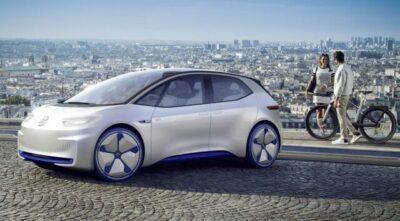|
Listen To The Article
|

German carmaker makes enormous investment in electric cars. Do they know something the rest of us don’t?
It is Volkswagen (OTC: VLKAY) and not Tesla Motors (NASDAQ: TSLA) that holds the electric-vehicle future. If just one-third of VW’s electric ambitions bear fruit, Tesla is doomed.
The German-auto giant plans to spend $82.5 billion on electrification; an unidentified source told Reuters. Fortune reported in November 2017 that VW has as many as 80 electric models on the drawing board. Note: Volkswagen itself refused to comment on this rumor which means it is nothing but speculation.
Some important specifics that indicate the rumor might be true include:
- Those plans will include five electric models in China by 2025, Volkswagen China CEO Jochem Heizmann told The Financial Times. Production of the first VW electric vehicles in the People’s Republic is supposed to begin in 2018.
- Volkswagen plans to start building its first all-electric vehicle in the United States by 2020, Electrek reported. They will build the I.D. Crozz Concept sport utility vehicle (SUV) in Chattanooga, Tennessee, a Volkswagen press release stated.
- A second electric vehicle, the e-Golf hot hatchback, will also be built at Chattanooga at some point in the future.
- Production of the e-Golf in Germany will be doubled to meet demand.
- Volkswagen plans to market two electric cars in California: the e-Golf and the ID Cross by 2019, Green Car Reports revealed.
- VW subsidiary Electrify America announced that it would build 500 fast-charging stations across the United States by June 2019, The Verge reported. Chargers will be installed at dealerships, and on highways, Porsche Cars North America CEO Klaus Zellme told Automotive News.
- Volkswagen subsidiary Porsche is planning two electric models: the Mission E and an electric SUV based on the Cross Turismo, The Verge Both vehicles are scheduled to be on the market in 2020.
- Volkswagen is so committed to electrics that it will change its logo to reflect a commitment to electrics, Bloomberg reported.
- Volkswagen will need up to 40 factories producing enough batteries to hold a gigawatt (one billion watts) of electricity by 2030, CNN reported. Each would be the equivalent of one of Tesla’s gigafactories. VW will need 150 gigawatts of electricity to power all the cars it wants to electrify, CNN claimed.
- Volkswagen’s Scania division has invested 10€ ($12.5 billion) in They plan to build a gigafactory battery-production facility and lab at Västerås, Sweden, Electrek reported.
- Volkswagen’s MAN subsidiary is testing an electric semi-tractor, Clean Technica reported.
- Volkswagen might have plans to electrify all 300 of its models by 2030, Electrek claimed.
Volkswagen Has The Money To Electrify
Volkswagen has the money to electrify as the automaker had $45.18 billion in cash and short-term investments on December 31, 2017, YCharts reported. That number was up from $43.3 billion in December 2016.
This fact means Volkswagen can pay for much, or perhaps all of its electric ambitions with the money it has in the bank. There will be no need to borrow or issue additional stock.
Volkswagen also reported a net income of $12.75 billion and earning $19.96 billion in cash from financing on December 31, 2017. Those funds came from annual revenues of $260.62 billion at the end of 2017. That number was up from $240.48 billion in December 2016, and $236.67 billion in December 2015.
Revenue figures indicate that VW has recovered quickly from the “dieselgate” scandal. The December 2017 annual revenue of $260.62 billion almost matches the December 2014 revenue number of $268.63 billion. If this continues, Volkswagen’s revenues will exceed the September 2014 high of $270.15 billion sometime next year.
To add icing to the electric cake, Volkswagen reported $506.508 billion in assets on December 31, 2017. That means it should have no trouble borrowing money if it needs to finance new plants or equipment to electrify.
Volkswagen not only has the money to electrify, but it also has the resources to borrow the money and develop the technology needed to make EVs a reality. That gives it an advantage Tesla will never be able to match: money.
Tesla Has No Money
Tesla Motors reported an “annual net income” of -$1.961 billion on December 31, 2017. That means it lost nearly two billion dollars during the year instead of making money.
Elon Musk’s company reported an “annual operating income” of -$1.632 billion on December 31, 2017. That means Tesla lost $1.632 billion from its operations.
Disturbingly, Tesla’s actual losses might be far more substantial, as the company reported an annual “free cash flow” of -$4.142 billion on December 31, 2017. That means Tesla may have lost more than $4 billion from its operations in 2017.
Tesla Is Not Making Any Money From Its Operations
Tesla Motors also reported an “investing cash flow” of around -$4.19 billion and an operating cash flow of -$60.65 million, which sounds incredibly low on the same day. There was one positive cash flow number at Tesla: it had a financing cash flow of $4.415 billion. This amount comes from the borrowing and financing of cars the company sells.
The bottom line is that Tesla is not making any money from its operations. Despite the losses, it had some money in the bank in the form of $3.523 billion in cash and short-term investments on December 31, 2017. This figure is low for the auto industry; the Ford Motor Company (NYSE: F) reported cash and short-term investments of $38.927 billion on the same day.
A disturbing conclusion that one can make here is that the money Tesla has in the bank came from the financing cash flow. That is, it might be money that Elon Musk borrowed. It might explain why Tesla has so little money in the bank, when the ailing Fiat Chrysler Automobiles (NYSE: FCAU) reported having $15.756 billion cash and short-term investments on New Year’s Eve in 2017.
Tesla Cannot Compete With Volkswagen
Here are a few nonfinancial numbers that prove Tesla clearly cannot compete with Volkswagen:
- Volkswagen operates 120 production plants in Europe alone. This statistic is an undercount because the figure does not include the VW factories in North and South America, Asia, and elsewhere.
- Tesla has two automobile production facilities: a large plant in Freemont, California, and a small facility in the Netherlands. A third factory in China is still on the drawing board.
- Volkswagen currently manufactures around 44,170 vehicles every week worldwide.
- News stories indicate that Musk will be struggling to manufacture 6,000 cars a week by June 2018. Elon himself admitted that the company is stuck in “production hell,” Wired reported.
- Volkswagen plans to increase production at its factory in Zwickau, Saxony, to 1,500 cars a day in the near future, Electrek reported. That means one VW factory can produce more than twice as many cars a week as Tesla’s maximum production.
A glance at the Volkswagen Group reveals that the $294.57 Tesla share price from April 19, 2018 was pure fantasy. The company lacks the resources to justify that price. The same data shows that Volkswagen AG (ETR: VOW3) was undervalued at $212.
Skeptics will wonder what the future of Tesla is. The simple answer is that Tesla will collapse and its remains will be gobbled up by another automaker. There are too many customers and too much high-quality technology at Tesla for a competitor like Tata Motors (NYSE: TTM) or Volkswagen to pass up. The Tesla brand will survive, but Elon Musk’s company will disappear.
I would not be surprised to see Tesla join the Volkswagen Group at some point in the future. Smart investors will ignore Tesla and buy through traditional automakers like VW.
 Off The Grid News Better Ideas For Off The Grid Living
Off The Grid News Better Ideas For Off The Grid Living



